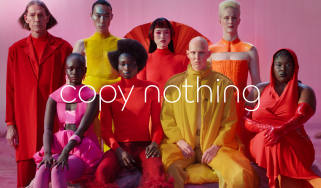Ian Callum interview: Jaguar design boss steps down after 20 years
Ian Callum explores his past and hints at his future as he announces his departure from Jaguar
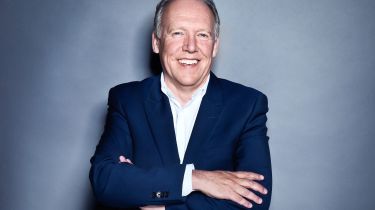
He always knew he would be a car designer. “My grandfather was a minister in Edinburgh,” Ian Callum told us, “I think what he instilled in me was that there has to be a reason to be here. And I’ve believed that ever since.
“I knew I had to do something special. I wanted to design cars.”
“When I was growing up, my father didn't have a car until I was about six years old. We didn't even know where they were made. They were just these exotic things that turned up in the street.
• The best concept cars of all time
“I remember seeing a Porsche 356 going past the house. And I saw another one in Edinburgh; my grandfather told me what it was. And it was at that point I decided that I wanted to design cars – I must have been about… well, I have been about four then.”
Now, sixty years on and with some of the most iconic British car designs to his name, Callum is stepping down as design director of Jaguar – the job he was born to do – after two decades at the helm. And he’s invited Auto Express in to his design studio for a chat.

“I started consciously drawing at a very young age. I must have been two or three years old. I used to copy things around the house. I loved drawing my mother's Hoover. And it was a Hoover, it was a proper Hoover.”
The fascination with cars followed quickly, helped by his lawyer father who was also secretary of the Scottish Motor Trade Association. That enabled him to introduce young Callum to a lot of the dealers, especially those in their home town of Dumfries.
While a love of drawing is nothing unusual in a child, the love of drawing cars didn’t go down too well with Callum’s teachers. “I remember I was in boarding school for a while in Perthshire and we used to have these jotters. And we were given tasks to do, like draw three planes of an object.
“I drew a side view of a car and a plan view of a car in pencil, all scaled up. I thought they were quite good. And I was 11 years old then.
“Then I got my jotter back and a little note saying, ‘Don't ever abuse your jotter again.’ And my teacher had ripped the pages out and thrown them away.”
“That fired me up. I think that was the point where I became probably quite a rebellious character in so many ways.”
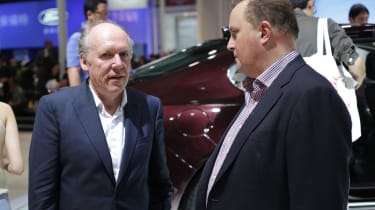
At 14, Callum famously wrote to Jaguar’s then engineering boss Bill Heynes asking how he could become a car designer. “I was a great fan of Jaguar by then. And the reason Jaguar was so popular in my mind was because it's probably the most exotic car I had seen on an everyday basis,” says Callum.
“I got a letter back and he said, ‘Well, you have to join Jaguar at a young age, become an apprentice, work through the factory and then we can train you to do technical drawing and you can go into the technical office."
I wrote back again and said, "No, you don't understand. I want to design the shapes of the cars," which basically, that was William Lyons’ job - that's what he did.”
After school, Callum had an unsuccessful stint on Lanchester Polytechnic’s car design course, went back to Scotland to art college in Aberdeen and then spent three years studying industrial design in Glasgow.
A first job in car design
An interview with Ford followed, but Callum’s heart was with another US giant, General Motors “GM, to me, was the company that designed the best looking cars, so I wanted to be part of GM,” he says.
Through a contact of his father’s, Callum managed to get an interview with legendary GM designer Wayne Cherry, who loved Callum’s work and wanted to send him to the famous Art Centre in California… but Callum would have to fund it himself.
“In the meantime, I'd been accepted for a bursary at the Royal College for Ford. But I didn't want to go to Ford. I was split. I wanted to be part of GM.”
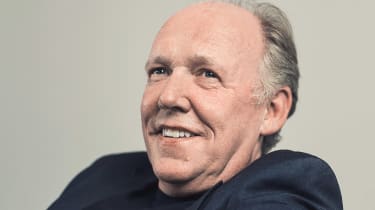
At the last minute, Callum accepted Ford’s offer, had what he describes as “two fantastic years” at the Royal College of Art, before joining Ford.
And the first thing he designed there? “I designed a wing mirror for a Transit van. And the second thing I designed was a wing mirror for another Transit.”
Next up was a steering wheel. But it gives Callum an opportunity to reminisce and sketch out the very steering wheel on the sketch pad in front of us.
His time at Ford included an introduction to Peter Horbury (now global head of design for Geely) where they ended up working on the Escort Cosworth together.
Before then, he travelled the world. “We travelled first class to Japan. I was there for just over a year with my best friend Chris Clements.
“We had a great time; we were young men, we were just ridiculously indulgent!”
The Ian and Chris dream team moved on to Australia, before Callum came back to Britain.
Ghia, TWR and the Aston Martin DB7
Next was a move to Turin to head up the Ghia studio, where he ended up being his brother Moray’s boss (Moray is now head of design for Ford). “I was so grateful for it because it wasn't for very long, but we became good friends. Before that, we were just brothers.”
Ghia saw such notable cars as the Via and Zig and Zag, with further travelling taking him to Brazil.
Family reasons saw him return to Dunton where his first job back was on another steering wheel – this time the first airbag-equipped wheel on a Granada.
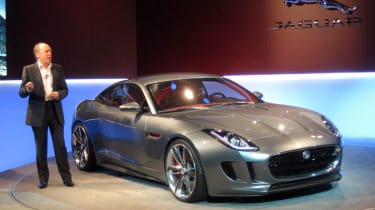
It’s fair to say that Callum wasn’t loving life at Ford back then.
“My frustrations built up and I got a phone call from my good friend Peter Stevens saying: ‘I know you're not particularly happy at the moment. Do you fancy working for Tom Walkinshaw?’ And I said, ‘Yeah.’
Callum had never met Walkinshaw before, but turned up at TWR HQ in Oxfordshire for his interview. “I thought I'd end up in this massive, super palace of a place. But it was Kidlington Industrial Estate. An industrial estate with tin sheds.”
Walkinshaw wasn’t even there when Callum arrived. “He was on the phone from Princes Street in Edinburgh – he said he’d be down in about an hour.”
Sure enough, Walkinshaw’s private jet flew over the buildings about an hour later and he offered Callum a job.
“We did all sorts of things. I met Ross Brawn and I helped him with the XJR-14 race car. Then we did a car for Jaguar. Tom saw the opportunity and said, ‘Well, I'll take XJ-S platform,’ which he knew well, ‘And we'll put a new body on it.’”
“Jaguar decided they didn't want it. And they didn't really tell us right away, but Tom had worked out they didn't want it.
“He came in, sat me down and said: ‘It's not going to work. I know they don't want it. I feel it.’ Tom was very instinctive. He said, ‘I'll be back. See you tomorrow.’
“He came back with a new contract from Aston Martin, from Walter Hayes. Tom told me, ‘I want you to continue with the car, but remember it's going to be an Aston now.’
“So it became the DB7. And that was the beginning of my career!”

Project Vantage followed, along with one of Callum’s personal favourites, the Vanquish. There was work on the DB9 and Vantage for Aston Martin, along with work for Volvo and Peter Horbury again, on the C70. Ford’s Richard Parry-Jones asked him to work on some sketches on the Ford Puma, too.
So with Callum well and truly on the global car design map, was there anything from his days drawing cars as a child that he’s carried through his career? “Simplicity,” he replied. “I think I learnt very early on just to not overdo things. And also I always looked for a way that things looked strong.”
Joining Jaguar
In 1999, Callum bumped into Ford design chief J Mays, who he’d never met before. “He said, ‘Nice to meet you.’ I was in awe of him, really. I still am. He said, ‘I'd like you to come back to Ford.’
“Eventually he came up with this offer to come and work at Jaguar to run the Advance Design Department.
“I went to meet [then Jaguar design boss] Geoff Lawson. We went out for dinner in London with a few drinks afterwards and we bonded quite well.”
However, Callum was never to work with Lawson. While in Australia he got a phone call telling him that Geoff Lawson had died suddenly.
Callum takes up the story: “Then a week passed and I was just ready to come back from Australia and I got a phone call from J.
“He said, ‘Oh, you heard about Geoffrey?’ I said, ‘Yeah, I have. It's very sad.’ He says, ‘Well, I'll cut to the chase. Job's yours.’ And I was actually quite shocked because I didn't think I was ready for it.
“So off I went. And of course when I arrived here, the advanced studio job was still open. I pulled Julian [Thompson, set to be Callum’s successor as Jaguar design director) into the role – I got another good friend and someone I could trust to do a good job.
“I remember standing in front of my team in the studio here, my second day, there was 100 people. I was handed this bloody lollipop mic and was asked to speak to them. And I just was standing there completely… I mean, my hands were shaking.
“I blurted out some pathetic sentences, saying, ‘This is going to be the most dynamic 10 years of this company,’ and all that sort of stuff. Walked away and thought: ‘You've got to get over this, mate. You cannot continue running a team not being able to talk to them properly.’
“I made my mind up that evening that I had to learn how to speak in public properly. Which I still can't do very well, but you know…”
We tell Callum that he does it pretty well these days, and he admits that at least he doesn’t get nervous any more.
Callum’s first job was to launch the ill-fated X-Type, a car that he successfully face-lifted later in its life, while he did a similar job with the X350 – the last of the three box XJs. “I really didn't have much warmth for either of them,” he says, “Because they were too traditional. But I went through it all. I did all of my PR stuff, talked them up.”
In the early days, with Jaguar and Aston Martin both still under Ford ownership, Callum worked on both brands. But that was something Aston boss Ulrich Bez put a stop to. “He felt I was focused too much on the Jaguar brand. And given a choice, the Jaguar brand is the one I'd have to choose anyway. Fair enough,” says Callum.
The first all-Callum Jaguar was 2007’s XK, followed by the XF – a pivotal car in Callum’s eyes: “My job was to move from the past to the present, and XF's the car that did that.
It was a lovely car and it still is a lovely car. It came out and we said, ‘This is the new face of Jaguar.’ I think we wowed the world with it, no doubt about it. And people got it. Yeah. People got it.”
The next generation of XJ also helped to move Jaguar forward, as Callum says: “When we came out with the XJ, I said: ‘Look. Right. We've raised the game here. We're going to do it again. I don't want you just to do a copycat. I want to go to another level.’
“In 20 years' time they'll think, ‘Wow, this is special.’ But there was a lot of pushback internally at the time. Oh my goodness!”
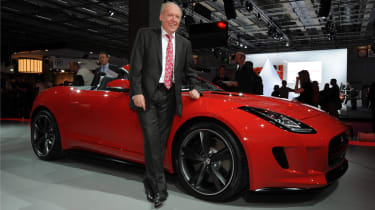
Jaguar was going through a tough period around that time. “We went through a huge financial difficulty and the government didn't help us, which is rather unfortunate.
“Funnily enough, Gordon Brown publicly apologised for that recently. He said, 'I know you were looking for money and we didn't help enough. For that, I apologise, like I have done for many things.'”
Until recently, the Tata years have gone well, especially on the Jaguar side, with a range of beautiful, strong-selling SUVs topped off by the brand’s first electric car, the multi award-winning iPace.
The F-Type is a car that’s very close to Callum’s heart and we leave the design centre in Whitley to head to Jaguar Classics HQ in Coventry in Callum’s own Velocity Blue F-Type Convertible.
“I choose a convertible because in today's age of driving, you have to maximise the effect of it,” he tells us. “And one of the best ways to do that is to get the roof off.
“I prefer the Coupe as an object of aesthetic, but the convertible is the car I choose because I enjoy driving it so much. So the F-type is my car.”
We move on to Callum’s candid view of Jaguar’s future and how he sees the brand. He reveals that he’s very happy with the model line up Jaguar has, but says the cars could afford to be more exotic – and at a higher price point.
“I think Jaguar could push up market. I think what we should do is create a similar volume with better, more expensive cars with better margins. That's where Jaguar's rightful place is.
“Unfortunate people within the business don't fully understand that around the world and that’s when the challenge sets in. The immediate notion is to start cutting price. That's not what we should be doing for Jaguar.
“I think that we've delivered world leading design, world leading products, and I think even engineering-wise we got world leading products, I just don't think that our ability to tell the story is strong enough yet, but I'm sure it will be.”
Looking back, and forward
We wander through the Classics collection of old Jags, with Callum marvelling over a 420G, an SS1 that he describes as ‘pure hot rod’ and the C-X75, which he says is his biggest disappointment that Jaguar didn’t make it.
He reveals that it’s the people he’ll miss most. “One of the reasons I'm going now, is because I feel we've got a great structure in Jaguar design, where I think I can be full of confidence the team is in place with the right people.
“The next generation of designers are going to be challenged in such a way that I've never been challenged.
“Now I wouldn't shrug that – if it came my way I would certainly embrace it. But I just think this is a set of challenges for another generation, really.
“I want to create my own challenges now.”
That’s the biggest hint Callum gives to what lies in his future. He’ll be working as a consultant for Jaguar, but there are other things in the pipeline, too.
Ian Callum may be leaving Jaguar, but one thing’s for sure – there’s plenty of fuel in his tank for more stunning work.
Which car design do you think Ian Callum will be best remembered for? Let us know in the comments...
Find a car with the experts




